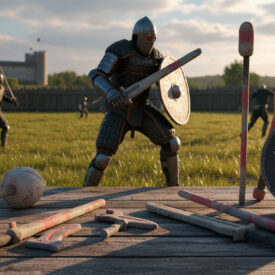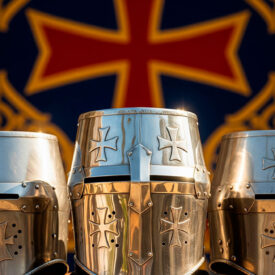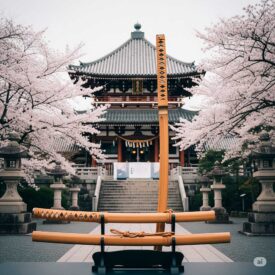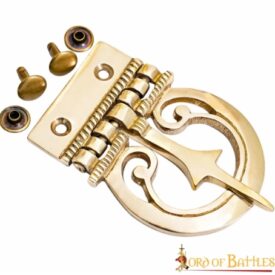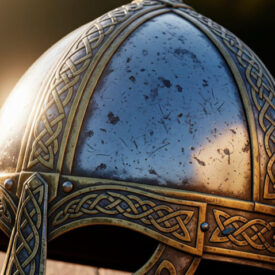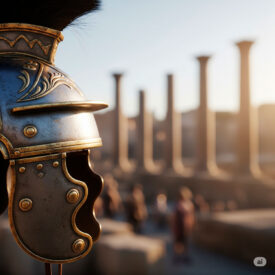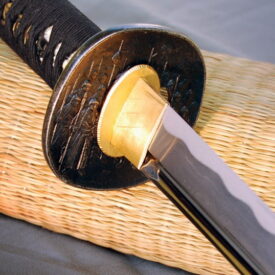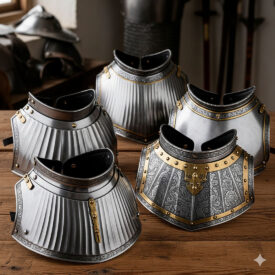What warrior hasn’t dreamed of feeling cold metal against their brow before going into battle? A medieval helmet is more than a piece of protection: it’s a statement, a symbol and an engineering work that encapsulates centuries of innovation and martial aesthetics. In this article you’ll discover its history, the most representative variants, how they were made, how to choose a functional or decorative replica and how to maintain it so it preserves its strength and epic presence.
Historical evolution of medieval helmets and helms
To understand why a helm has a particular shape you must read its history. From the need to protect the head in combat to the aesthetic integration with the full suit of armour, every technical change responded to a real challenge on the battlefield. Below is a concise chronology that places the key milestones in order.
| Period/Date | Event |
|---|---|
| Late Antiquity / Protohistory | |
| 10th century BC | Wenceslas nasal helmet. A functional replica is based on the original preserved in Prague; design attributed to this period. |
| 9th century BC | Nasal helm. Indicates an origin in the 9th century BC; (according to sources) it became the predominant defensive weapon in the 10th century and was popular among Vikings and Normans. |
| Early Middle Ages (9th – 12th centuries) | |
| 10th century | Wenceslas nasal helmet (functional replica). Replica based on the helmet type attributed to this period. |
| c. 1011 | Teapot helm. Steel helm shaped like a hat, used in the early Early Middle Ages. |
| 11th century | Spangenhelm. Germanic helm widely used in the Early Middle Ages; design of reinforced metal strips. |
| 11th century | Basinet (origins). Begins to develop; will be used until the first third of the 15th century. |
| 11th century | Capellina / pava / capelina. Helm shaped like a wide-brimmed hat. |
| 1050 – 1250 | Period of evolution of Early Medieval helmets. Significant technological development in helmet design and manufacture. |
| High/Late Middle Ages (late 12th – 13th centuries) | |
| Late 12th century | Cervelliere. Hemispherical, close-fitting helm, introduced in the late 12th century; worn alone or beneath mail; precursor to the basinet. |
| Late 12th century | Enclosed helm (early great helm). Late 12th-century development that gave rise to the great helm. |
| Late 12th century (c.1180) | Great helm (heaume, pot helm, bucket). Appears in the context of the Crusades; evolution from the nasal helm (flat-topped variant with square profile). |
| c. 1180 | Medieval Crusader helmet. Typology inspired by helms used by crusaders around 1180. |
| 12th–13th centuries | Cruader helm. Use and functional variants from this period. |
| 13th century | Castile helm. Medieval steel helmet, gauge 18, dated to this century. |
| c. 1240–1250 | Cervelliere. Example shown in the Morgan Bible illustrating its use at this time. |
| Late Middle Ages (14th – late 15th centuries) | |
| c. 1330 | Basinet. Iron helm covering ears and neck; “Sugar Loaf” (pot) variant dated around 1330. |
| 14th–15th centuries | Basinet. Widely used; bowl shape protecting head and neck, evolving toward helmets with movable visors. |
| 14th century | Low medieval helm with bevor. Use of bevors and development of variants with visors and nape protection. |
| 14th century | Kettle helmet. Type of helmet documented in this century. |
| 14th century | German basinet with visor. “Battle-ready” examples inspired by 14th-century designs. |
| Late 14th – early 15th century | Hundsgugel. Helmet with elongated, pointed facial protection, adopted by knights to display status. |
| Early 15th century | Sallet. Replaces the basinet; protects the nape with an extended tail and has a movable visor; refinement of the basinet. |
| c. 1407 | Barbute. Italian evolution of the basinet with a T- or Y-shaped facial opening. |
| c. 1407 – 1440 | Functional Italian barbute. Example dated c.1440 (piece from the Anvant armour at Kelvingrove Museum, Glasgow). |
| Early 15th century | Armet. Helm that fully covers head and neck with a visor; appearing c.1420, replacing some helm and sallet variants. |
| Early 15th century | Closed helm. Heavy helm from the early 15th century offering full protection. |
| Early 15th century | Frog-mouthed helm (stechhelm). Helm without a visor used mainly in tournaments. |
| c. 1480 | Functional Gothic sallet. With pegged visor, chinstrap and inner padding (examples dated around 1480). |
| c. 1480–1490 | German sallet and sallet with visor. Replicas and pieces dated c.1480–1490 show regional evolution of the sallet. |
| Late 15th century | Armet. Articulated, close-fitting helm, a masterpiece of armour forging with several moving parts for complete closure. |
| Renaissance and early modern era (16th – 17th centuries) | |
| 16th century | Burgonet. Derives from radical modification of the sallet; popular in the 16th and 17th centuries; round helmet with cheek pieces and crest. |
| Early 16th century | Morion. Appears in the kingdom of Castile as an evolution of 15th-century headgear; popular in the 16th–17th centuries, associated with conquistadors and infantry. |
| 16th–17th centuries | Cabasset. Simple pear-shaped helmet used by infantry in the 16th and 17th centuries. |
| Regional observations | |
| 1150 – 1230 AD | In the Iberian Peninsula there are early depictions of helmets with closed facial protection predating many of the variants that appear elsewhere in Europe (period 1150–1230 AD). |
The chronology illustrates how function drives form: when the threat from blunt weapons and projectiles increases, the helmet closes and is reinforced; when mobility and vision matter more, smiths open slits and design visors. That tug-of-war between defense and visibility defines the morphology of each era.
Essential types and how to identify them
Knowing helmet families lets you read a piece at a glance. Here are the most influential types, their period and tactical function.
| Type | Period | Protection | Visibility | Recommended use |
|---|---|---|---|---|
| Spangenhelm | 5th–11th centuries | Moderate (strip construction) | Good | Skirmishing and light cavalry |
| Nasal helm | 9th–12th centuries | Reinforced frontal protection | Excellent | Mounted combat |
| Great helm (heaume) | Late 12th–14th centuries | Very high (face included) | Limited | Tournaments and heavy cavalry |
| Basinet / Sallet | 14th–15th centuries | High | Good with visor raised | Battle and guard duty |
| Barbute | 15th century | High | Good | Light cavalry and nobles |
| Armet / Armets | Late 15th–16th centuries | Maximum (articulated) | Variable | Heavy cavalry and tournaments |
How to recognise a quality functional replica
- Gauge and metal thickness: Good-quality steel with uniform thickness ensures strength without excessive weight.
- Riveting and welding: Rivets should be well set and welds clean.
- Interior padding: A liner or leather padding riveted in place indicates real functionality.
- Finish and heat treatment: Proper polishing and controlled heat treatment prevent fatigue fractures.

Materials, techniques and decoration: the art of forging
The transition from bronze to iron and finally to steel opened a range of possibilities. Steel allowed for thinner, stronger helmets. Smiths used techniques such as hammering, quenching and repoussé to shape and reinforce plates.
Decoration was not mere whim: heraldic engravings, gilding and enamels identified loyalties and rank. Even crests had a practical purpose in indicating hierarchies and serving as identification points amid the chaos of battle.

Key technical procedures
- Hot hammering: To give the dome the curve and strength it needs.
- Controlled quenching: Hardens steel in specific areas without making it brittle.
- Repair and riveting: Well-executed welds and rivets maintain structural integrity.
Regional variations and symbolism
Helmet design reflects local traditions. In Scandinavia nasal reinforcements and partial masks predominated; in the Mediterranean conical, ornate shapes were preferred; in Western Europe the great helm emerged under the influence of feudal cavalry.
Beyond defensive use, helmets communicated status. Engravings, paint and crests were not mere ornament: they were a visual language on the battlefield.
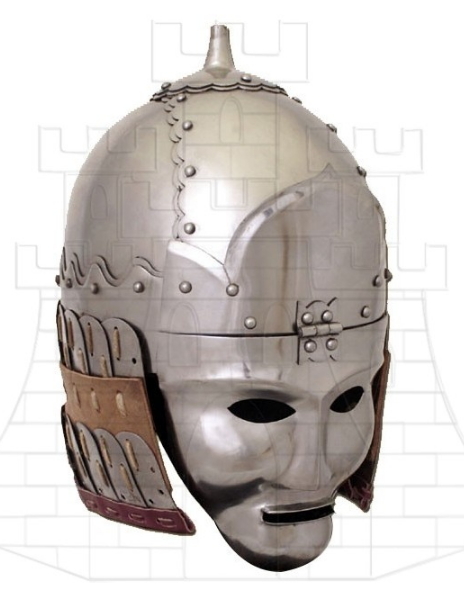
How to choose your helmet: practical criteria
Choosing a helmet depends on the intended use: display, historical reenactment, LARP, or real combat. Here is a step-by-step guide to decide wisely.
- Define the use: For LARP aim for safety and lightness; for historical reenactment prioritize authenticity and materials; for display choose aesthetic details.
- Material and finish: Quenched steel for functional use, polished or decorated steel for display.
- Size and fit: Try the helmet with the padding you will use; a loose helmet creates dangerous impact points.
- Visibility and ventilation: Balance protection and sight according to your discipline.
Basic maintenance so your helmet endures
Well-cared-for helmets preserve their integrity and appearance. Check rivets, remove moisture, apply oil to unvarnished metal parts and store with a cotton lining.
Accessories and adaptations
- Internal liners: Leather or fabric pads to adjust size and absorb impacts.
- Chinstrap: Essential on closed helmets to prevent the piece from shifting.
- Interchangeable visors: Useful on functional replicas to alternate protection and visibility.
Practical comparison: which helmet to choose according to use?
| Use | Recommended type | Advantages | Limitations |
|---|---|---|---|
| Historical reenactment (battles) | Basinet / Sallet | Good balance between protection and mobility | May require visor maintenance |
| LARP / events | Light helm or padded replicas | Lightness and safety | Less historical authenticity |
| Display | Decorated helm / Great helm | Visual impact and detail | Reduced visibility |
| Historic combat tournaments | Armet / Armets | Maximum protection | Cost and weight |
Find your ideal medieval helmet
Basinets
Barbutes
Burgonets
Sallets
Kettle-Capelines
Morions
Sallet
Spangenhelm
Helms
We clear up questions about medieval helmets
What were the most innovative techniques in medieval helmet manufacture?
The most innovative techniques in medieval helmet manufacture include the selective hardening of certain areas to reinforce critical points while keeping other parts flexible, which optimised impact absorption. Advances were also made in joining techniques, moving from simple rivets to more elaborate methods to better secure the structure and integrate elements such as protective mail at the lower edge to shield the neck and nape. In the Late Middle Ages, the use of high-quality steel and the process of controlled quenching allowed for stronger, lighter helmets, together with precise manual hammering and forming to shape plates. Additionally, movable visors and complex ventilation systems were developed to balance protection, vision and comfort. Finally, personalisation and close fit to the wearer were key elements, achieved thanks to precise measurements and specialised forging techniques like repoussé, welding, polishing and quenching.
How did cultural differences influence the design of medieval helmets?

Cultural differences influenced helmet design by adapting shape, materials, decoration and functionality to the traditions, combat techniques and resources available in each region. For example, Scandinavian helmets had distinctive nasal protections, while those of the eastern Mediterranean used conical shapes and detailed decoration, reflecting styles and symbolism of each culture. Also, designs incorporated heraldic and symbolic elements that indicated rank and social status, showing helmets were not just protection but also cultural and social expressions. These differences resulted from the interaction between specific military techniques and regional artistic traditions, as well as the availability of materials and metallurgical knowledge in each area.
What materials were commonly used to construct medieval helmets?
The materials commonly used to build medieval helmets were primarily iron and steel. During the Middle Ages smiths worked with good-quality iron and developed selective hardening techniques to reinforce certain areas of the helmet, balancing protection and flexibility. Metal mail was also used to protect the neck and nape, with rings carefully riveted or welded for stability. Although modern reconstructions may use lightweight or synthetic materials, historically metal was essential for a helmet’s function and durability.
How did medieval helmets evolve throughout the Middle Ages?
Medieval helmets evolved from simple, open designs to fully enclosed and reinforced structures. Initially, during the Early Middle Ages, helms such as the nasal helm were used, with a protective nose bar and often combined with mail to protect the neck and throat, favouring mobility and visibility. Later, with the rise of heavy cavalry in the High Middle Ages, heavier, enveloping helmets such as the pot helm and the great helm appeared, offering full facial and head protection at the expense of some visibility and lightness. Over time, improvements in forging techniques and availability of steel made these advances possible, reflecting the need to better protect against increasingly lethal and sophisticated weaponry.
What distinctive features did Viking helmets have?
Viking helmets were typically made of iron, robust in construction and focused on practical protection in combat. Notable distinguishing features include:
- They had a rounded dome covering the head, often with a reinforced ridge running longitudinally and transversely for greater structural strength.
- They incorporated an iron nasal guard protecting the central face without obstructing vision or breathing.
- Some, like the famous Gjermundbu helmet, included a partial face mask covering eyes and nose for extra protection.
- The design sought a balance between lightness and strength, with inner lining of leather or cloth to cushion blows and improve comfort.
- Contrary to popular myth, they did not have horns; those are a later invention of popular culture.
- In some cases bronze decoration or engravings indicated social or military status while preserving functionality.
In short, Viking helmets were practical, unpretentious pieces designed to protect effectively in combat by combining structural simplicity, strategic reinforcements and some identifying ornamentation.
| Oil type | Main characteristics | Recommended use |
|---|---|---|
| Mineral oil | High penetration, does not degrade or attract dirt | Regular protection and maintenance |
| Camelia oil | Natural, acid-free, non-volatile | Antioxidant protection, lubrication |
| Lithium grease | Thick, long-lasting, does not evaporate | Long-term storage protection |
- Mineral oil
-
- Main characteristics: High penetration, does not degrade or attract dirt
- Recommended use: Regular protection and maintenance
- Camelia oil
-
- Main characteristics: Natural, acid-free, non-volatile
- Recommended use: Antioxidant protection, lubrication
- Lithium grease
-
- Main characteristics: Thick, long-lasting, does not evaporate
- Recommended use: Long-term storage protection
A medieval helmet tells stories: of battles won, positions defended and artisans who turned metal into legend. If you are drawn to authenticity, look for pieces made with historic techniques; if you prefer to take part in events, prioritise safety and comfort. In any case, a well-chosen and maintained helmet will connect you to the past in a tangible and exciting way.

